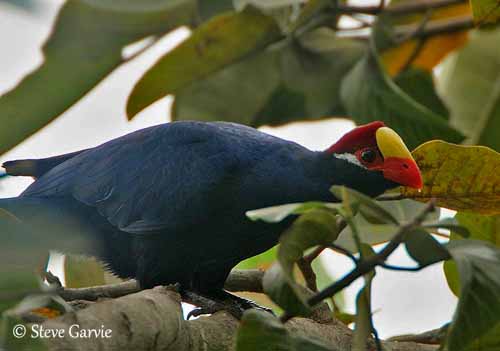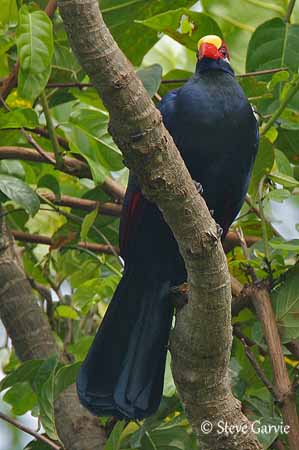
Fr: Touraco violet
All : Schildturako
Esp : Turaco Violáceo
Ital : Turaco violetto
Nd : Violette Toerako
Sd : Violett turako
Photographers :
Steve Garvie
RAINBIRDER Photo galleries
Text by Nicole Bouglouan
Sources :
HANDBOOK OF THE BIRDS OF THE WORLD vol 4 by Josep del Hoyo-Andrew Elliott-Jordi Sargatal - Lynx Edicions - ISBN: 8487334229
BIRDS OF AFRICA SOUTH OF THE SAHARA by Ian Sinclair and Peter Ryan - Princeton University Press Princeton and Oxford - ISBN: 0691118159
BIRDS OF THE GAMBIA AND SENEGAL by Clive Barlow and Tim Wacher – Helm Field guides – ISBN: 0713675497
L’ENCYCLOPEDIE MONDIALE DES OISEAUX - Dr Christopher M. Perrins - BORDAS - ISBN: 2040185607
BirdLife International (BirdLife International)
Violet Turaco
Musophaga violacea
Musophagiforme Order – Musophagidae Family
BIOMETRICS:
Length: 45-50 cm
Weight: 360 g
DESCRIPTION:
As other turacos, the Violet Turaco is usually “seen” among the tree foliage. It is also called “Violet Plantain-eater”.
The adult has glossy violaceous blue-black plumage overall. Upperparts and wing-coverts are violet-blue. The tail is similar but washed green.
On the underparts, chin and throat are glossy violaceous blue-black. The area from breast to upper belly is similar but less glossy and washed green. Lower belly and thighs are black.
When the bird is flying, the crimson primary and outer secondary’s flight feathers are conspicuous. They are tipped brown.
On the head, crown and nape are crimson. Ear-coverts are white.
We can see a large, convex bright yellow frontal shield over the red bill. The eyes are dark brown, with bright red lores and bare orbital skin. Legs and feet are blackish.
Both sexes are similar.
The juvenile lacks the conspicuous head and bill patterns. The bare areas around the eyes are dark. The bill is blackish. The head is matt black.
VOICE: SOUNDS BY XENO-CANTO
The Violet Turaco utters rapid, resonant rolling phrases of guttural notes, and loud series of deep “caws” often uttered by several birds at once, involving an almost continuous cacophony.
We can also hear a single gruff while the bird is feeding.

HABITAT:
The Violet Turaco frequents forested areas such as forest galleries, edges and borders along streams in dry savannahs, and along drainage channels with large fruiting trees. It can be seen in parks and gardens where it finds tall trees.
This species occurs from sea-level up to 1000 metres of elevation.
RANGE:
The Violet Turaco is found in the forests of tropical West Africa, from S Senegambia and Guinea, E to N Nigeria and NW Cameroon, extending S to the coast in Ivory Coast, Ghana and Togo.
BEHAVIOUR:
The Violet Turaco is mainly a fruit-eater, taking fruits and berries, figs from Ficus, but also seeds. Figs are swallowed whole. It also consumes insect larvae for proteins.
It forages in trees, using the running along branches and tree-hopping habits. However, this species is mostly seen in flight, but it may remain inconspicuous and motionless among the vegetation if disturbed. But it occasionally descends to the ground for bathing and drinking.
They are gregarious and move in flocks of about 10-12 birds.


The Violet Turaco is often seen in pairs and they breed solitary in a territory strongly defended by both mates.
At the onset of the rainy season, courtship displays are observed. We can hear much more calling. The birds chase each other from tree to tree. The head pattern is displayed and the crimson wing patches are enhanced by spreading the wings.
This species is probably sedentary, but there is no available information.
FLIGHT:
The Violet Turaco takes off with powerful wingbeats followed by glides. This flight enhances the crimson wing patches.
This red colour is typical in turacos, coming from copper-based pigment, the “turacine”, giving the name “turaco”.
REPRODUCTION:
The breeding season is synchronous with the rains but varies with the range, and occurs in April in Senegambia and between June and October in Nigeria.
The Violet Turaco builds a flimsy, flat nest with sticks and twigs, similar to Columbidae nests. It is placed in a leafy tree, at about 6 metres above the ground.

The female lays 2 oval, greyish-white eggs. Both sexes incubate during 24-26 days. The chicks are fed by regurgitation. They become very active 2-3 weeks later, and clamber into the surrounding branches. They are able to fly at about 4-5 weeks of age, but they still depend on parents for food.
DIET:
The Violet Turaco feeds primarily on fruits, berries and figs from Ficus. It also takes seeds, leaves, buds and flowers, and insect larvae for proteins during the nesting period, and also snails and slugs.
PROTECTION / THREATS / STATUS:
The Violet Turaco is locally common according to the area and even very common in suitable habitat.
However, the populations of Guinea, Sierra Leone, Liberia and Ghana are heavily trapped for bird-trade.
But this species is not currently threatened.